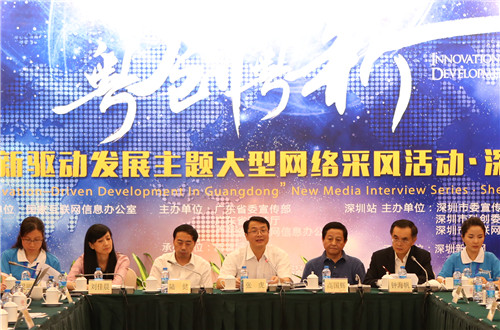Shenzhen, a pilot city for China's reform and opening up, is poised to become a world-leading innovation hub. And the city will take part in a higher level of global cooperation and competition, according to local officials.
Zhang Hu, the executive vice mayor of Shenzhen, said the city is seeking to achieve the transformation from applied technology innovation to innovations of core and frontier technologies.
"Shenzhen has taken a leading position in the world in 4G technology, metamaterials, gene sequencing, new energy cars, and so on. Five of the six enterprises in the country that rank global top 50 for patent cooperation treaty (PCT) patent applications come from Shenzhen," Zhang said.
The vice mayor made these remarks on July 23 during a meeting with representatives from domestic Internet media groups, who are on a five-day visit to Guangdong to find out about the province's innovation-driven development efforts.
He further informed, Huawei based in Shenzhen emerged as the largest filer in the world of "global" PCT patents in 2014, and ZTE corporations ranked the third. Kuang-Chi Science Ltd is the owner of more than 86 percent of patents in the global metamaterials field.
BGI, the world's largest genomics organization headquartered in Shenzhen, accounts for half of the whole world's gene sequencing output capacity. It has recently acquired the CGI gene sequencing company in the US, realizing the integration of international talents and innovative resources.
 |
|
Zhang Hu(center), the executive vice mayor of Shenzhen, speaks during a meeting with representatives from domestic Internet media groups on July 23. [Photo provided to China Daily] |
"The government has helped the establishment of 45 industry-university-research institute alliances in sectors such as cloud computing, Internet of things, and satellite navigation," the vice mayor highlighted government roles. "These institutes will mainly focus on original innovation, R&D, as well as industrialization, in a bid to boost emerging industries", he mentioned.
According to Zhang, the total scale of Shenzhen's strategic emerging industries reached 1.9 trillion yuan ($306 billion) in 2014, 20 percent more than the year before. The added value in the sector accounted for 35 percent of its GDP in the same year.
So far, the city is home to more than 30,000 technological companies and 4,742 national-level high-tech enterprises, nearly half of the total number in Guangdong province.
As a typical immigrant city, Shenzhen boasts an average age of 29.5 among its population as well as an innovation culture. "We advocate innovation, and we are also tolerant to failures," Zhang said.
Though it won't be an easy path, there are difficulties in at least five aspects for Shenzhen to ascend to the world's top as an innovation center, believe experts. The city desperately needs high-level talents, as well as greater fiscal input for scientific research.
Industrial transformation and upgrading is another urgent task. Shenzhen is also facing the bottleneck of limited land resources, which can be barriers for the settlement of innovation carriers there, say experts.
Guadalupe, a 55-year-old lady living in Spain, has been practicing tai chi for almost 20 years. She believes tai chi is not only a kind of martial art but a complete system of fusing traditional Chinese culture.

One of the potentially most traumatic things a girl has to go through is finding a new hairdresser.